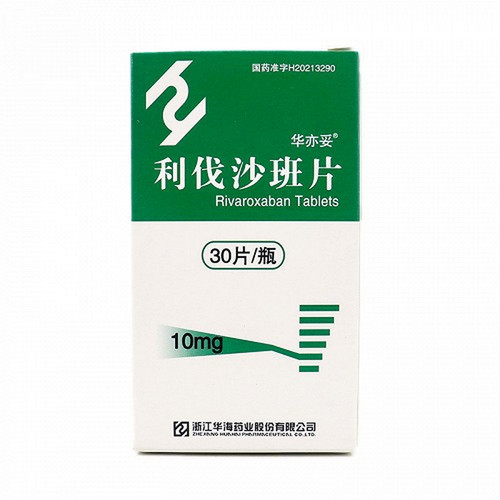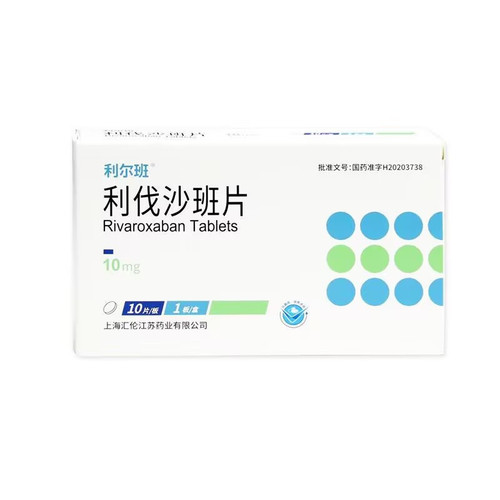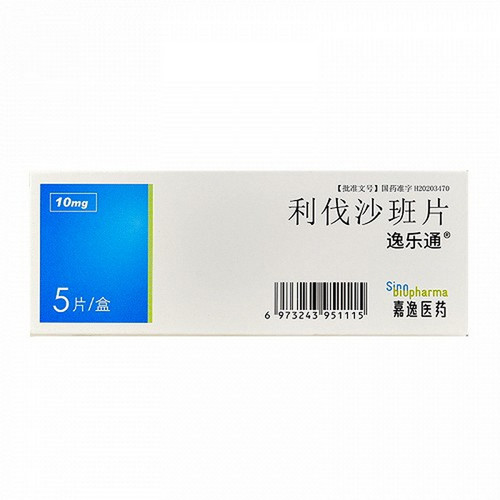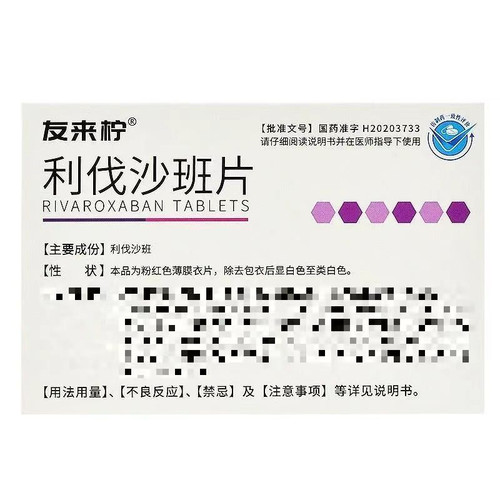Product Overview
[Drug Name]
Generic Name: Rivaroxaban Tablets
Trade Name: Dongyang Sunshine Rivaroxaban Tablets 10mg x 30 Tablets
[Main Ingredients]
Main Ingredient: Rivaroxaban. Chemical Name: 5-Chloro-nitro-({(5S)-2-oxo-3-[-4-(3-oxo-4-morpholino)phenyl]-1,3-oxazolidin-5-yl}methyl)-2-thiophene-carboxamide. Molecular Formula:
C19H18CIN3O5S. Molecular Weight: 435.89
[Properties]
This product is a pink, round, film-coated tablet that appears white or off-white after removal of the coating.
[Indications/Main Functions]
1. For the prevention of venous thrombosis (VTE) in adult patients undergoing elective hip or knee replacement surgery. 2. For the treatment of deep vein thrombosis (DVT) and pulmonary embolism (PE) in adults; for reducing the risk of recurrent DVT and/or PE in patients whose risk persists after completing at least 6 months of initial treatment. (For patients with hemodynamically unstable PE, see [Precautions]). 3. For the reduction of the risk of stroke and systemic embolism in adult patients with non-valvular atrial fibrillation and one or more risk factors (e.g., congestive heart failure, hypertension, age ≥75 years, diabetes, history of stroke or transient ischemic attack). Limited data are available on the relative effectiveness of rivaroxaban compared with warfarin in reducing the risk of stroke and systemic embolism, provided the condition is well controlled on warfarin.
[Specifications]
10mg x 30 tablets
[Dosage and Administration]
Rivaroxaban Administration: Oral. Rivaroxaban 10mg can be taken with or without food. Rivaroxaban 15mg or 20mg tablets should be taken with food. The recommended dose for preventing venous thrombosis in adult patients undergoing elective hip or knee replacement surgery is rivaroxaban 10 mg taken orally once daily. The first dose should be taken between 6 and 10 hours after surgery if wound bleeding has stopped. For patients undergoing major hip surgery, the recommended course of treatment is 35 days. For patients undergoing major knee surgery, the recommended course of treatment is 12 days. If a dose is missed, patients should take rivaroxaban immediately and continue taking it once daily the following day. Treating DVT and PE and reducing the risk of recurrent DVT and PE: The recommended initial dose for acute DVT or PE is 15 mg twice daily for the first three weeks; after the initial treatment period, the recommended dose for subsequent treatment is 20 mg taken orally once daily, administered approximately at the same time each day. Short-term treatment (at least three months) should be considered for patients with DVT or PE caused by significant transient risk factors (e.g., recent major surgery or trauma). Longer-term treatment should be considered for patients with DVT or PE due to causes other than significant transient risk factors, patients with unprovoked DVT or PE, or patients with a history of recurrent DVT or PE. For patients at persistent risk of DVT and/or PE after completing at least 6 months of standard anticoagulant therapy, rivaroxaban 10 mg orally once daily is recommended to reduce the risk of recurrent DVT and/or PE. For patients at high risk of recurrent DVT or PE (e.g., those with complex comorbidities, or those who experience recurrent DVT or PE while receiving rivaroxaban 10 mg once daily), rivaroxaban 20 mg once daily should be considered. Treatment duration and dose selection should be determined on an individual basis after careful assessment of treatment benefits versus bleeding risks (see [Precautions]). See Table 1 for details. (For other details, see the package insert.)
[Adverse Reactions]
See the package insert for details.
[Contraindications]
Rivaroxaban is contraindicated in the following patients: 1. Patients with hypersensitivity to rivaroxaban or any of the excipients in the tablets. 2. Patients with clinically significant active bleeding. 3. Lesions or conditions with a significant risk of major bleeding, such as current or recent gastrointestinal ulcers, malignant tumors with a high bleeding risk, recent brain or spinal injury, recent brain, spinal, or ophthalmic surgery, recent intracranial hemorrhage, known or suspected esophageal varices, arteriovenous malformations, vascular aneurysms, or major intraspinal or intracerebral vascular malformations. 4. Except in special circumstances for switching anticoagulants or administering unfractionated heparin (UFH) at doses required to maintain central venous or arterial catheter patency, concomitant treatment with any other anticoagulants, such as UFH, low molecular weight heparins (enoxaparin, dalteparin, etc.), heparin derivatives (fondaparinux, etc.), and oral anticoagulants (warfarin, apixaban, dabigatran, etc.) is contraindicated. 5. Patients with liver disease associated with coagulation abnormalities and clinically relevant bleeding risk, including patients with Child-Pugh class B and C cirrhosis. 6. Pregnant and lactating women.
[Precautions]
See package insert for details.









